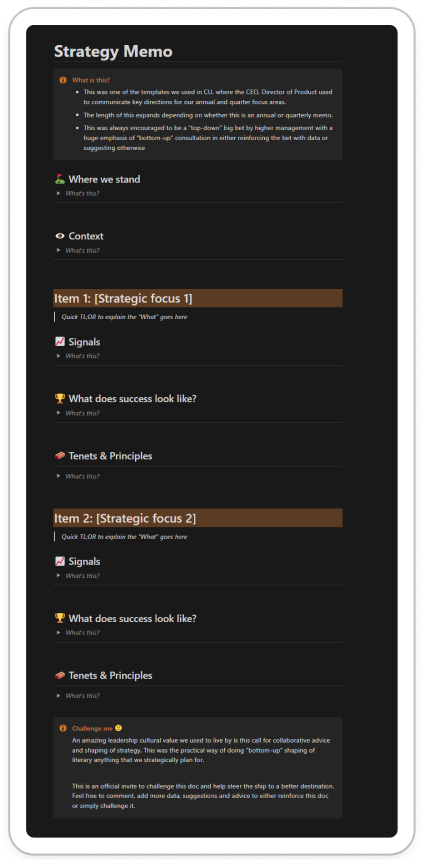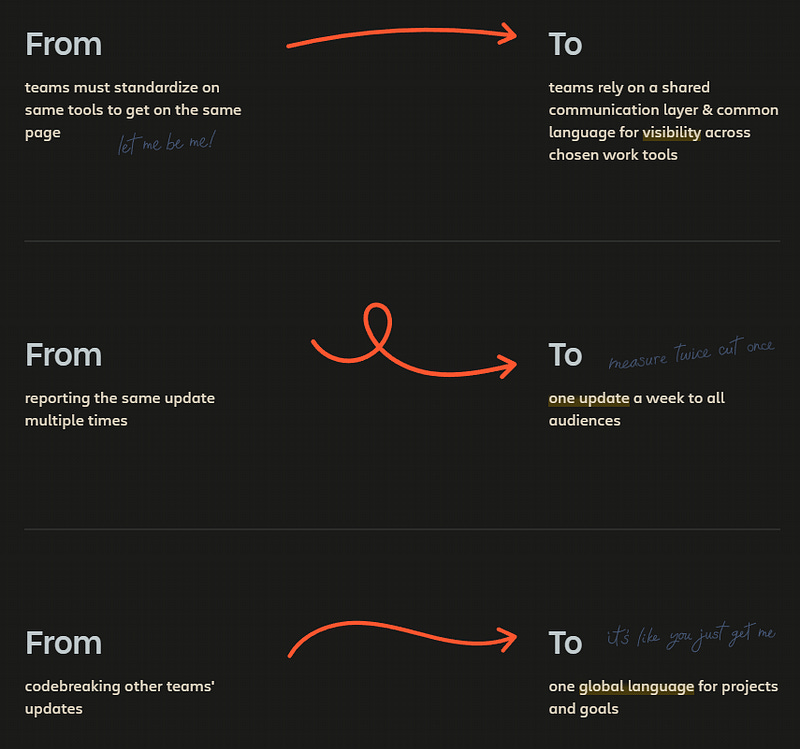Mastering the Art of Strategic Communication with the ‘Strategy Memo’ [Notion Template]
A template we used in ClickUp to communicate quarterly and annual key product strategic focus
A template we used in ClickUp to communicate quarterly and annual key product strategic focus
In the fast-paced world of product management, clear and strategic communication is paramount.
One tool that I found essential is what I like to call the “Strategy Memo” — a doc product leaders use to communicate quarterly or annual strategic focus that ends up shaping our OKRs
This was among the practices we used during my time at ClickUp where the top executives (CEO or Director of Product) would share this with us on a quarterly (or annual) cadence.
Its brilliance lies not just in conveying strategic direction, but in fostering a culture of cross-collaboration and clarity. Today, I want to dive into the nuts and bolts of this template and how it can revolutionize your approach to strategic planning and execution. [And share a ready-to-use template 😉]
Also a side-disclaimer: This is an adjusted version of how we used to do things in ClickUp. I always like to structure things and create templates from repetitive work I see in my experience and this is an attempt to do so. So it wasn’t structured this way, but with time, I managed to see patterns and created this template out of it 🤓
OK, what is a ‘Strategy Memo’?
Before we start, it’s not a complete strategy doc (not the typical product strategy doc) but a tool that helps guide our thought process for the quarter or year
So it’s something that usually influences our OKRs and the goal of it is to ensure alignment & clarity before nailing our OKRs on the wall.
Key principles of this doc
This practice also embodies fundamental principles and values that you (or your organization) might not agree with, but it was a culture I enjoyed in ClickUp and have always strived to create in every company I land in.
So here are the key philosophies behind this practice:
1) Strategy is a collaborative effort
A strategy memo isn’t a monologue; it’s the start of a conversation. I’ve always seen this in some companies where a leader will just close the door, jot things, and come out from the den with a firm pitch that is bound to any alteration of change. It’s obviously not their intention but it has bad consequences on the culture and how effectively things get done.
Encouraging your team to advise, challenge, and contribute to this document is crucial. It’s a practice that not only enriches the strategy but also empowers your team, fostering a culture of ownership and innovation, and more importantly CLARITY & ALIGNMENT!
2) Leaders should put in the work too
The Strategy Memo is an attempt to have leaders “do the work” on nailing the key aspects of what they preach. I’ve seen it a lot where key strategic initiatives or OKRs are planned and discussed in a one-meeting call or simply “directed” (aka said) by an executive.
Ever heard of “Failing to Plan is planning to fail”?
Well, that’s the result of an unstructured way of thinking around key strategic focus areas that will end up guiding your entire quarter's work. Without a structured and detailed way of communicating a strategic imitative and making sure research, clarity, and alignment are done properly, confidence in any direction will be lacking
3) Common vocabulary is the best route to autonomy
I’ve encountered individuals who fear templates or structured ways of working as this negatively impacts diversity in thinking.
I honestly believe that complete autonomy is also harmful, especially when it comes to inexperienced teams! Yes, this can sometimes lead to lateral thinking and innovation, but it’s scarce, especially for startups where time is their riskiest currency.
But don’t get me wrong, I’m also against complete rigidity in terms of how people are supposed to work. No one wants to feel like a robot in a system.
Both extremes are bad and that’s why I believe all teams need to benefit from working the way they want, but with guardrails to keep inter-team communication easy and efficient. After all, the top reason for failing in anything in almost all the retros I do boils down to a “lack of effective communication”.
So, working on some guardrails (like this template) is simply agreeing on the common questions all teams should answer before, during, and after their projects [this philosophy is highly explained in Atlassian Loop, which is an amazing attempt of taking their beliefs/values and converting them into practical rituals]
Digging deeper into the template
The template is composed of the below key sections:
⛳ Where We Stand
Here, the key is brevity and impact. As leaders, we need to concisely summarize past achievements, linking them directly to business outcomes. This section isn’t just about patting backs; it’s a strategic reflection to set the stage for what’s next.
Ask yourself, “What were our wins and how do they set the foundation for upcoming initiatives?”
👁 Context
This is your executive summary but with a twist. It’s not just what we’re doing; it’s the compelling ‘why’ behind it. For instance, when we decided to build Whiteboards at ClickUp, it wasn’t a random addition. It was a strategic move to improve productivity, meeting a growing demand for translating “thinking” using visual tools into “doing” immediately in ClickUp, which is something we heard a lot in the discovery interviews we used to have with our customers.
After this, we’ll include the following sections for each strategic focus (as you’ll see in the shared template below)
📈 Signals
Data is your roadmap here. It’s not about overwhelming readers with numbers but presenting insightful analytics that justify your strategic focus. Show how customer feedback, market trends, or product usage statistics directly influence each of your strategic decisions. This is that part where you appeal to the logical part of the mind.
🏆 What Does Success Look Like?
Success can be a moving target, but in this section, we pin it down. Set tangible goals, both qualitative and quantitative. For instance, “Success means achieving a 10% increase in daily active users, coupled with positive user feedback on ease of use.”
🧱 Tenets & Principles
This is where you align your strategy with your product’s ethos. If innovation is a core value, how does your strategy foster it? This section should be a reflection of your product’s DNA in action, guiding your strategic approach. It’s also a great opportunity for leaders to indulge a little bit in the “how to”, basically laying some suggestions about the solution space.
Wrapping up…
The Strategy Memo is more than a document; it’s a strategic tool that aligns, inspires, and mobilizes. As product leaders, our goal is to not just lead but to listen, adapt, and evolve. The Strategy Memo is a testament to this ethos, and I encourage you to embrace its potential in your strategic endeavors.
Grab the template here 🤓 (don’t forget to follow me for more practical templates in product management very soon)
I’d love to hear how you implement strategic communication within your teams. Share your experiences, adaptations, and insights on the Strategy Memo approach in the comments below.



